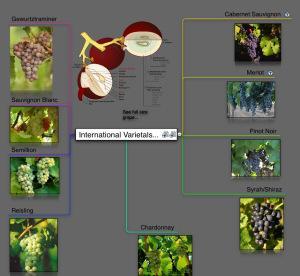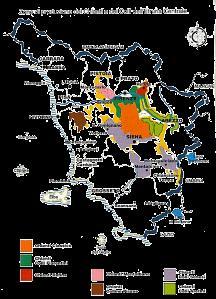International Grapes
Italy has more than 600 indigenous grapes – more than any other country in the world. So why would Italian wine producers turn to international grapes? I’ve just attended a tasting that attempted to answer that question with nine wines.
The international grapes are those that are planted in many wine-growing regions around the world. Most experts agree on the following list: Cabernet Sauvignon, Chardonnay, Gewurtztraminer, Merlot, Pinot Noir, Riesling, Sauvignon Blanc, Semillion, and Syrah.

International Varietals
There are three main reasons Italians might make wine from non-native grapes. First of all, international grapes are relatively easy to grow. Second, they also have wide consumer recognition. Finally, you can blend them with indigenous grapes to get the flavor you want – in Italy these wines are not governed by either law or tradition.
The issue with wines made from international grapes is this: can and do they reflect terroir, or are they only made to please the (export) public?
The most famous of the Italian wines made from international grapes are the Super Tuscans. They were created in the 1970s to gain US market share from the French. Also, producers wanted to ignore the DOC/DOCG regulations make make what they wanted to make. Ironically, many of the original Super Tuscans now qualify as DOC or DOCG wines, although some producers still prefer to use the IGT (Indicazione Geografica Tipica) classification of Toscana.
Wine Notes
All of these are good wines. Whether or not they reflect terroir depends on the native grapes blended with the international grapes. Whether or not reflecting terroir is important is a matter of individual choice.
Whites
Producer: Castello di Ama
Name: Al Poggio 2009
Region: Tuscany
Grapes: 75% Chardonnay, 25% Pinot Grigio
This producer is best known for Chianti Classico. They consider this an entry-level white wine.
Very pale yellow, fresh, elegant. Made in a light style. Aged a few months in used barrique.
Nose: grass, white flower, white peach, a little bit of spicines
Palate: soft, low acid, good minerality
Producer: Bastianich (Yes, it’s Chef Lidia Bastianich’s family.)
Name: Vespa Bianco 2008
Region: Fruili Venezia Giulia
Grapes: 45% Chardonnay, 45% Sauvignon Blanc, 10% Picolit (an especially difficult grape to grow)
Vespa means wasp; Picolit is known to attract a lot if insects. Aged in barrels.
Pale yellow, clear. Very elegant, although high in alcohol at around 14%.
Nose: almond, green, citrus, apple
Palate: vanilla, fresh, high acid, long finish
Producer: Castello della Sala (Antinori)
Name: Cervaro della Sala 2008
Region: Umbria
Grapes: 85% Chardonnay, 15% Grechetto
The Antinori family has been making near Florence for 700 years. They bought the property in Umbria around 50 years ago.
Darker yellow, almost gold. Transparent rim shows aging in barrel (8 months in French oak)
Nose: intense – oak, yellow fruit, sweet spices
Palate: rich, full for an Italian white, dense buttery feeling
Super Tuscans

Wine regions in Tuscany
Producer: Villa di Capezzana
Name: Carmignano 2006
Grapes: 80% Sangiovese, 20% Cabernet Sauvignon
This wine is made west of Florence, in an area cooler than most of Tuscany. Cabernet Sauvignon was planted in this region around 200 years ago. Garnet red.
Nose: red berry, anise, earthy, dry herbs
Palate: fruit tannins that are a bit harsh, high acid, minerality, savory/umami mushroom
Producer: Argiano
Name: NC Non Confunditur 2008 Rosso Toscana 2008
Grapes: 40% Cabernet Sauvignon, 20% Merlot, 20% Syrah, 20% Sangiovese
The name “Non Confunditur” means “Don’t get confused.” The producer wants to ensure you that it’s not their usual wine. Dark garnet color.
Nose: blackberry, black cherry, pepper, bell pepper. intense, ripe fruit.
Palate: juicy, round, soft tannins, medium body
Producer: Antinori
Name: Tignanello 2007
Grapes: 80% Sangiovese, 15% Cabernet Sauvignon 5% Cabernet Franc
This producer made pretty much the first Super Tuscan. They used to make Chianti Classico, until they decided to do something different. Aged in French barrique for almost two years.
Very age-worthy wine. (In general, age-worthy Super Tuscans can age 15-20 years, but after that they go downhill.) Garnet red.
Nose: dry fruit, tobacco, dry herbs, anise – very complex.
Palate: fruit, acid, dense and soft. full bodied with well-integrated tannins.
Other Reds
Producer: Conterno Fantino
Name: MonPrà 2009
Region: Piemonte (Langhe)
Grapes: 45% Nebbiolo, 45% Barbera, 10% Cabernet Sauvignon
High alcohol wine, aged in French oak. Medium red color.
Nose: berries (both dark and red), sweet spices, roses from the Nebbiolo
Palate: orange peel, juicy, some weight, high acid, persistent finish
Producer: Gaja
Name: Langhe Sito Moresco 2008
Region: Piemonte
Grapes: 35% Nebbiolo, 35% Merlot, 30% Cabernet Sauvignon
They were one of the first in the region to introduce international grapes. This wine is made in a more modern style, and meant to be affordable wine. Aged in French barrels for less than a year. Ruby red color.
Nose: floral (rose) and bell pepper
Palate: creaminess, round, soft. non-aggressive tannins. ripe fruit. nice finish.
Producer: Donnafugata
Name: Contessa Entellina Tancredi 2007
Region: Sicily
Grapes: 70% Nero d’Avola, 30% Cabernet Sauvignon
Very dark red, showing a little bit of age.
Nose: very intense – spice, pepper, dark fruit, leather, some cinnamon from the oak.
Palate: long finish, some tannins, vanilla from the oak
